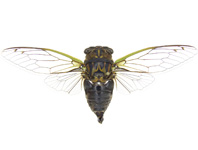Abstract
Sterling’s Toothed Toad, Oreolalax sterlingae (Nguyen et al. 2013), was described from near the summit of the highest peak in Vietnam, Mount Fansipan, Lao Cai Province. The species is the only member of the genus in Vietnam and is presently known from a single stream system on Mount Fansipan at about 2800 m elevation. The closest congener occurs more than 200 km away in China (Fei et al. 2010), and the relationship of O. sterlingae within the genus is not known. Because of its extremely small range and profound habitat modifications and pollution at the site, O. sterlingae was recently assessed as Critically Endangered (IUCN SSC 2015).
References
Altig, R. & McDiarmid, R.W. (1999) Body plan: development and morphology. In: McDiarmid, R.W. & Altig, R. (Eds.), Tadpoles: The Biology of Anuran Larvae. University of Chicago Press, Chicago, pp. 24–51.
Fei, L., Ye, C.Y., Huang, Y.Z. & Liu, M.Y. (1999) Atlas of Amphibians of China. Henan Science and Technology Press, Zhengzhou, 432 pp.
Fei, L., Ye, C.Y. & Jiang, J.P. (2010) Colored Atlas of Chinese Amphibians. Sichuan Publishing House of Science and Technology, Chengdu, 519 pp.
Gosner, K.L. (1960) A simplified table for staging anuran embryos and larvae with notes on identification. Herpetologica, 16, 183–190.
IUCN SSC Amphibian Specialist Group (2015) Oreolalax sterlingae. The IUCN Red List of Threatened Species 2015: e.T76491633A76491638.
http://dx.doi.org/10.2305/IUCN.UK.2015-4.RLTS.T76491633A76491638.en
Li, C., Guo, X.G. & Wang, Y.Z. (2011) Tadpole types of Chinese megophryid frogs (Anura: Megophryidae) and implications for larval evolution. Current Zoology, 57, 93–100.
https://doi.org/10.1093/czoolo/57.1.93Nguyen, T.Q., Phung, T.M., Le, M.D., Ziegler, T. & Böhme, W. (2013) First record of the genus Oreolalax (Anura: Megophryidae) from Vietnam with description of a new species. Copeia, 2013, 213–222.
https://doi.org/10.1643/CH-12-021Palumbi, S.R., Martin, A., Romano, S., McMillan, W.O., Stice, L. & Grabowski, G. (1991) The simple fool’s guide to PCR. Department of Zoology, University of Hawaii, Honolulu, 47 pp.
Schneider, C.A, Rasband, W.S. & Eliceiri, K.W. (2012) NIH Image to ImageJ: 25 years of image analysis, Nature Methods, 9, 671–675.
https://doi.org/10.1038/nmeth.2089

